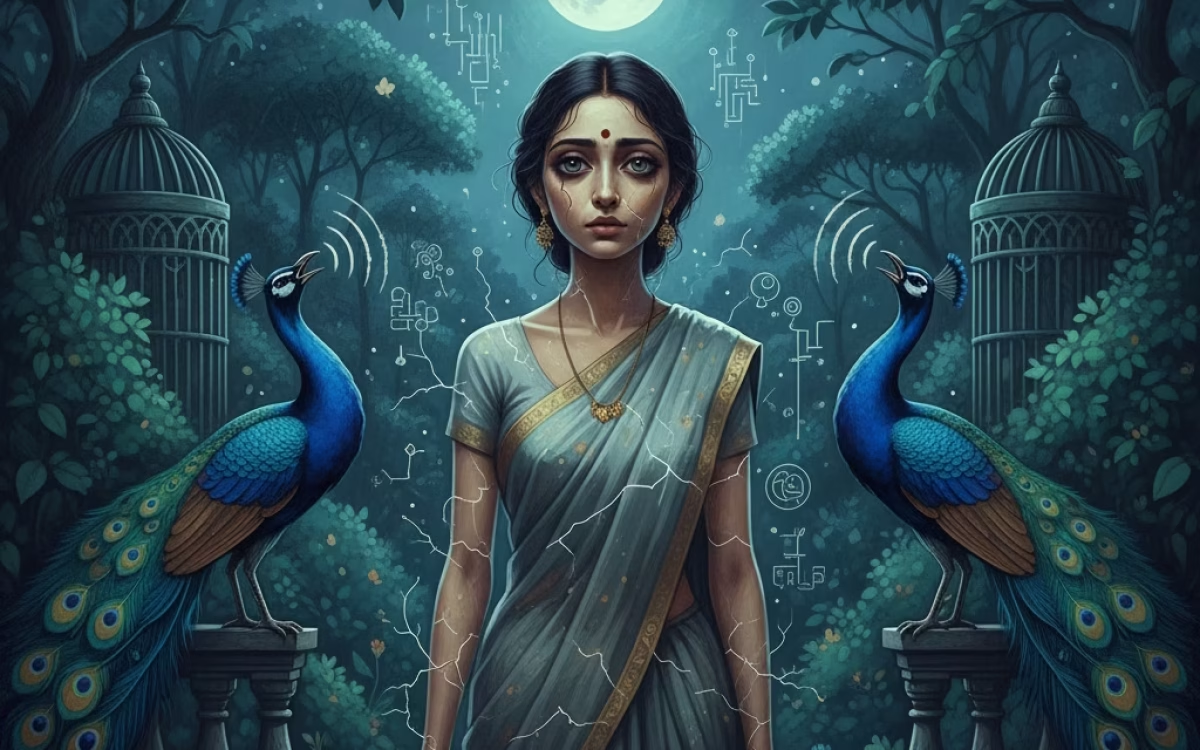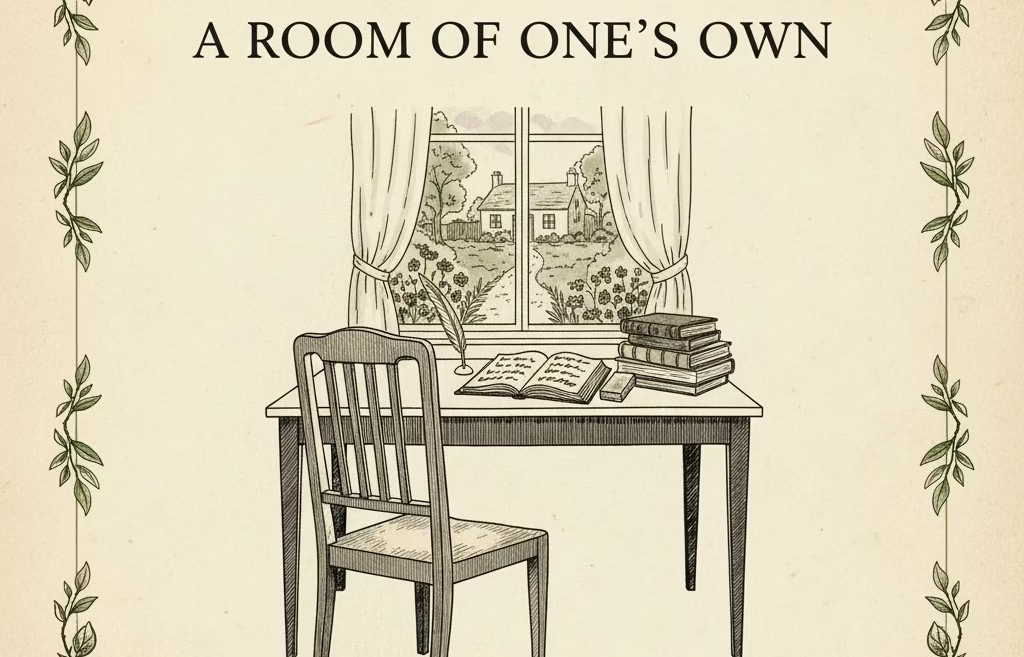Introduction: The Haunting World of Cry the Peacock
Cry the Peacock, Anita Desai’s first novel, published in 1963, stands as a landmark in Indian English literature. What sets it apart is its rare psychological depth and unique narrative style. At the center of this haunting story is Maya—a sensitive woman whose world is shattered by a childhood prophecy of doom that hangs over her marriage.
After losing her mother early, Maya is raised within the protective cocoon of her affectionate father in the historic city of Lucknow. She grows up privileged but vulnerable, caught in a world of innocence and existential dread. Maya is, in every sense, a tragic figure—torn between what she wishes to believe and what fate has in store for her.
Desai’s novel isn’t just about domestic unhappiness; it’s a harrowing descent into the labyrinth of the human mind. Using the stream-of-consciousness technique, Desai masterfully reveals Maya’s psychological turmoil. The narrative constantly shifts between memories and present anxieties, mimicking the fractured nature of Maya’s consciousness. Her mind is gripped by a “mute horror”—the inescapable shadow of fate.
This storytelling method offers a visceral reading experience. Readers gain intimate access to Maya’s fears, spirals of fantasy, and fragmented thoughts. The cry of peacocks during the monsoon—a symbol deeply rooted in Indian tradition, evoking beauty and impending death—haunts Maya’s troubled psyche. Furthermore, it becomes a metaphor for the fragile boundary between life and death, love and madness.
Mid-twentieth-century India provides the social and cultural backdrop. Here, Desai explores the gendered confines imposed on women with quiet precision. Gautama, Maya’s rational and emotionally distant husband, contrasts sharply with her poetic, sensitive nature. Also, their marriage highlights a deep rift—shaped and widened by Indian patriarchal realities. But the novel’s vision goes beyond the personal. It captures not only Maya’s psychological distress, but also the silent suffering of many Indian women trapped in lonely marriages and overwhelming societal expectations.
Reading Cry the Peacock is like stepping inside an intense, often unspoken world. It’s a world of emotional alienation and yearning—something that resonates strongly with Indian readers who know family pressures, societal roles, and the lifelong search for self amid cultural constraints. Furthermore, this fusion of psychological depth, poetic symbolism, and artistic vision is what places Anita Desai’s novel not only as a cornerstone of Indian fiction but also as a powerful voice for the interior lives of women.
Anita Desai’s Cry the Peacock: Plot Overview
Anita Desai’s Cry the Peacock follows Maya, a sensitive and privileged young woman from Lucknow. She is haunted by a childhood prophecy. Specifically, the astrologer predicted that either Maya or her husband would die four years into their marriage. Moreover, Maya was raised by a loving father after her mother died. Consequently, she grew sheltered and emotionally dependent.
She is married to Gautama, an older lawyer who is rational and emotionally distant. However, Gautama cannot meet Maya’s deep psychological needs. This, in turn, stirs a strong sense of isolation and growing anxiety in her. The novel opens with Maya grieving for her pet dog, Toto. This loss then reminds her of other sorrows and intensifies her loneliness. Furthermore, their marriage is childless, which makes Maya feel even more isolated.
As time passes, the distance between Maya and Gautama grows wider. He dismisses her fears and avoids emotional closeness. Therefore, Maya becomes trapped in her escalating neurosis. Recurring images and the mournful cry of peacocks constantly appear. Gradually, the peacock’s call becomes a powerful symbol of Maya’s dread. The story also uses a stream-of-consciousness style. As a result, this blurs the line between reality and Maya’s delusions. It immerses readers in her fragmented and obsessive thoughts.
Moreover, Maya’s paranoia and distress steadily intensify. She becomes convinced that either she or Gautama must die. The astrologer’s prophecy thus weighs heavily on her mind. Meanwhile, her sense of abandonment and misunderstood longing grows stronger. In the climax, Maya pushes Gautama from the rooftop. In a moment of madness, she kills him.
Afterward, Maya does not feel relieved. Instead, she is overwhelmed by guilt and madness. Ultimately, she is left alone. Her tragic fate fulfills the old prophecy most devastatingly. Overall, the novel explores loneliness, marital alienation, gender expectations, and the line between sanity and madness. Finally, Desai brings these themes alive with poetic symbolism and strong feminist insights. FULL TEXT
Anita Desai’s Cry the Peacock: Symbolism
Anita Desai’s narrative is replete with evocative symbols that extend far beyond their literal meaning, serving as windows into Maya’s disturbed emotional state and the broader human condition.
The Peacock’s Cry: A Song of Life and Death
The titular peacock, with its plaintive cry echoing through the monsoon rains, is the most potent symbol in the novel. Traditionally associated in India with beauty, pride, and virility, Desai reinvents the peacock as a harbinger of doom and a metaphor for Maya’s complex relationship with life and death.
Peacocks are said to “know their death beforehand,” and their cry is mournful and foretelling. For Maya, the peacock’s call symbolizes a paradoxical coexistence of vitality and impending mortality—“life-in-death” and “death-in-life”.
This symbol reflects Maya’s acute self-awareness and obsession with the prophecy that foretells death in her marriage within four years. The peacock’s dance during the rainy season blends love and desperation, mirroring Maya’s emotional oscillation between yearning and despair.
Shiva’s Dance: Creation, Destruction, and Liberation
Maya’s fascination with the bronze statue of Nataraj, the dancing Shiva, adds another layer of symbolism. Shiva’s cosmic dance signifies both creation and destruction—a duality that resonates deeply with Maya’s inner conflict.
The dance metaphor underscores Maya’s struggle to balance the instinct to live fully with the knowledge of inevitable decay and loss.
For Indian readers, the image evokes cultural memory, linking personal suffering to cosmic cycles and offering a glimpse of spiritual transcendence amid psychological torment.
Toto the Dog: Symbol of Lost Innocence and Emotional Void
The novel opens with the death of Maya’s pet dog, Toto, an event heavy with symbolic meaning. Toto represents not just a beloved companion but an emotional substitute for the child Maya never had.
Her grief over Toto’s death signifies the depth of her loneliness and the fragile emotional world she inhabits.
The cold indifference of Gautama, her husband, to Toto’s death highlights the emotional chasm in their relationship—mirroring the broader theme of communication failure and isolation in their marriage.
Anita Desai’s Cry the Peacock: Feminist Themes
Anita Desai’s Cry the Peacock subtly but powerfully critiques the patriarchal structures that confine women like Maya in silent suffering.
The Quest for Identity Amid Patriarchal Expectations
Maya’s character embodies the conflict between individual desire and societal roles imposed on Indian women.
Despite Gautama’s rationality and care, his intellectual detachment and emotional distance exacerbate Maya’s feelings of isolation and inadequacy.
The prophecy about death looms like an invisible barrier, cutting Maya off from hope and happiness—mirroring how many Indian women are trapped by fatalistic cultural narratives and expectations of obedience.
The Emotional Costs of Repression
The novel does not portray Maya’s neurosis as mere madness but as a poignant response to emotional neglect and repression.
Maya’s hysteria and eventual breakdown underscore the psychological costs of silencing women’s voices within marriage and society.
The absence of children, her yearning for affection symbolized by her pet, and her desperate mental state expose the societal failure to acknowledge women’s emotional needs beyond their traditional roles.
A Feminist Reclamation Through Narrative Voice
Desai’s use of Maya’s fragmented, stream-of-consciousness narration gives voice to inner turmoil often suppressed in Indian cultural contexts.
By focusing on Maya’s psychological complexity, Desai challenges simplistic stereotypes of Indian womanhood and illuminates the nuanced, painful realities many women face.
Also, the narrative creates empathy and understanding rather than judgment, making Cry the Peacock a subtle but radical feminist text ahead of its time.
Anita Desai’s Cry the Peacock: Stream-of-Consciousness
Desai’s narrative method immerses the reader in Maya’s mind, exposing us to the relentless churn of thoughts, fears, and secret hopes.
The flashback device draws out hidden memories, making each symbol (a bird, a bronze statue, a fleeting aroma) shimmer with meaning.
Maya shifts between first-person recollections and interior monologues, revealing the disconnect between outer harmony and inner chaos.
Example: The recurring image of Maya washing away pain at the tap after Toto’s death is less a literal action than a psychological gesture for cleansing memory—a motif echoing the ritual purity and emotional catharsis so central to Indian culture.
Desai’s style—lush, sensitive, sometimes frantic—captures the pulse of neural tension in every line. Moreover, reading Maya’s thoughts is like tracing watercolors bleeding across paper, unpredictable yet dazzlingly honest.
Anita Desai’s Cry the Peacock: Critical Perspectives
Literary critics praise Desai’s ingenious blending of psychological fiction with Indian tradition. Her prose, rich with metaphor and symbol, invites analysis at every level—from undergraduate classrooms to research seminars.
The novel’s modernist underpinnings, alongside its rootedness in Indian cultural patterns, have made it a fixture in academic syllabi.
Various readings—from Freudian psychoanalysis to sociocultural critique—provide fresh interpretations, opening channels for discussion about gender, trauma, and family negotiation. EXPLORE OTHER WRITERS
Conclusion
In Cry the Peacock, Anita Desai crafts more than a tale of tragedy—she paints an intimate portrait of Maya’s psychological suffering in a world that often refuses emotional authenticity. Moreover, the symbolism running throughout the novel—the mournful cry of the peacock, the cold moon, the silent dog—does not just serve poetic ends; it expresses Maya’s deeper yearning for love, connection, and understanding.
Furthermore, Desai exposes the consequences of emotional neglect within a patriarchal society. Consequently, Maya’s journey is marked by loneliness and misunderstanding. Importantly, her story is not an isolated drama, but a reflection of countless women whose wishes are muffled by tradition and social pressure. Although sheltered in childhood, Maya finds herself woefully unprepared for the realities of marriage and the emotional void left by Gautama’s distance. Also, as a result, her tragic fate—a descent into neurosis, obsession, and finally violence—becomes inevitable, fueled by the anxiety left by both social prophecy and personal longing.
Through Maya’s fractured psyche, therefore, Desai urges readers to acknowledge the cost of silencing women’s needs. In particular, her nuanced depiction of psychological instability, alienation, and emotional starvation is both empathetic and critical. Above all, it reminds us that love, fulfillment, and selfhood must not be denied to anyone, regardless of gender or circumstance.
By blending poetic symbols with feminist insight, Desai’s novel leaves us with a haunting question: How many cries, like Maya’s, echo unanswered in homes everywhere? Ultimately, the answer lies in our willingness to listen. In its artistic depth and emotional honesty, Cry the Peacock endures as a powerful commentary—and a plea for awareness—about the fragility of the human mind and the overlooked needs at the heart of every life.
Frequently Asked Questions (FAQs)
Q1: What is the main theme of Anita Desai’s Cry the Peacock?
A1: The novel explores psychological trauma, marital alienation, feminist struggle, and the conflict between tradition and personal freedom.
Q2: Who is Maya in Cry the Peacock?
A2: Maya is the sensitive and neurotic protagonist whose emotional turmoil and paranoia drive the narrative.
Q3: What symbolism is used in Cry the Peacock?
A3: The novel uses the peacock’s cry as a symbol of impending doom and Maya’s fragile psyche, alongside motifs like Shiva’s dance and the silent dog representing loss.
Q4: How does Anita Desai portray feminist themes in the novel?
A4: Through Maya’s psychological struggles, the novel critiques patriarchal norms and highlights the emotional silencing and repression of women.
Q5: What narrative technique is predominant in Cry the Peacock?
A5: Desai employs a stream-of-consciousness style that reflects Maya’s fragmented thoughts and increasing obsession.





